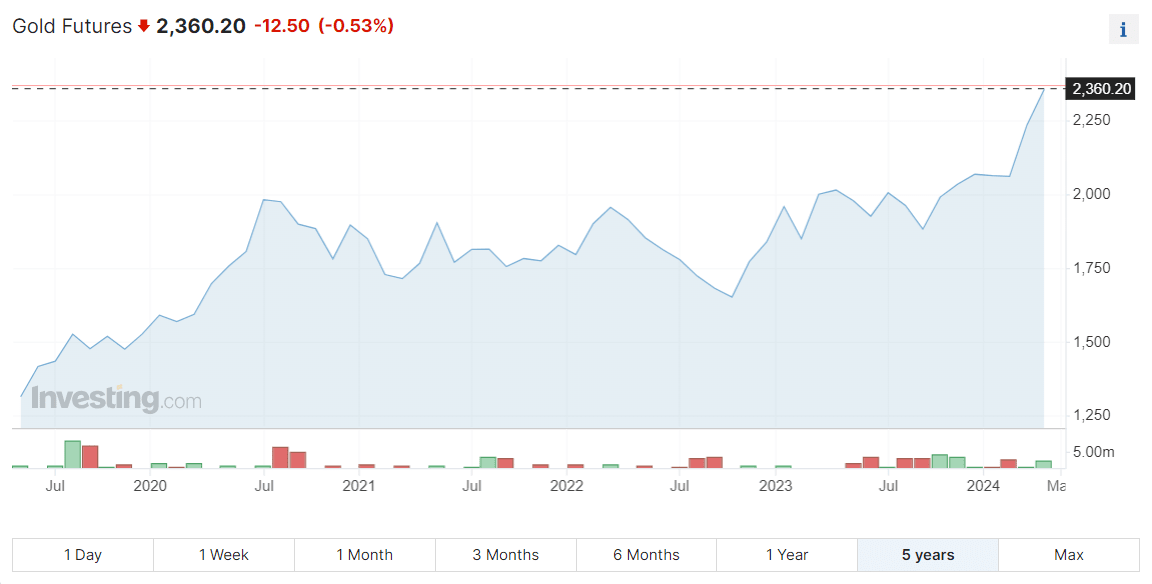Gold rose to a new record price

As a result of the world's geopolitical instability, the price of gold has risen to a new record level. Many expected the price of gold to rise as inflation skyrocketed a year ago, but the price of gold remained largely stagnant.
The world's central banks have bought gold in their vaults with urgency, and thanks to that, the price of gold has finally broken through its technical resistance level and set a new record at the beginning of April at $2,365.
Gold Futures Price (in USD), five-year monthly chart

Central banks, led by China, have been on the buying side of gold for quite some time. The financial competitors of the USA want to reduce their dependence on the US dollar, and in this situation gold has historically been the most popular place to park money. Central banks see gold as a safe haven and store of value in times of economic and geopolitical uncertainty.
Gold is generally seen as a resilient investment. When interest rates fall, the price of gold generally rises as gold becomes a more attractive investment than interest-paying government bonds.
China's central bank bought gold for the 17th month in a row in March while increasing its reserves by 160,000 ounces, bringing the central bank's total reserves to 72.74 million ounces of gold.
The central banks of India and Turkey have also strengthened their gold reserves. India's stable GDP growth supports the country's central bank's gold investments.
The March inflation readings published at the end of last week caused the price of gold to drop from its peaks. US Consumer Price Index (CPI) inflation was 0.4 percent in March, when the market expected 0.3 percent. Annual inflation in March also barely covered expectations, ending up at 3.5 percent. The monthly core-CPI inflation also rose a bit more than expected, at 0.4 percent.
According to Diego Colman (The DailyFX Strategy), three drivers can explain the dynamics of the gold market at the moment.
- The trap of trend following: A strong rise in gold may be based more on momentum than fundamentals and this may lead to a price bubble and subsequent correction.
- Financial ruin: The strong rise in the price of gold may reflect growing fears of a "hard landing" as a result of the rapid tightening of the interest rate screw. Gold as a safe haven provides protection against chaos if a crisis materializes.
- The return of inflation when interest rates are lowered: Gold investors may be taking a long-term view as they wait for the Fed to cut interest rates in an election year. The loosening of monetary policy can lead to a new wave of inflation, and that’s a scenario that historically supports the price of gold.
Launched by Vontobel TLNG KULT V366-turbo offers a leveraged product for profit seeking in the rising price of gold futures. At the time of writing, turbo's leverage is 9.02 times, which corresponds to a 9.02 percent return for the leveraged product when the price of gold futures rises by one percent. However, if the price of the gold future falls by one percent, the investment in the leveraged product will result in a loss of 9.02 percent.
With Vontobel's leveraged products, you can aim for returns even in the falling price of gold futures.TSRT KULT V453 turbo at the time of writing offers 12.56x leverage on gold futures returns. If the price of the gold future falls by one percent, the leveraged product produces a profit of 12.56 percent. Turbo's value, on the other hand, decreases by 12.56 percent if the price of the gold future rises by one percent.
Vontobel's investment products can be traded during the opening hours of the Helsinki Stock Exchange. When trading leveraged products, the risk of loss increases. Losing the entire invested capital is possible. The underlying gold future is quoted in US dollars, so the yield of the leveraged product also depends on the price changes of the EUR/USD currency pair. Investors bear Vontobel's credit risk when investing in Vontobel's products.
Risks
External author:
This information is in the sole responsibility of the guest author and does not necessarily represent the opinion of Bank Vontobel Europe AG or any other company of the Vontobel Group. The further development of the index or a company as well as its share price depends on a large number of company-, group- and sector-specific as well as economic factors. When forming his investment decision, each investor must take into account the risk of price losses. Please note that investing in these products will not generate ongoing income.
The products are not capital protected, in the worst case a total loss of the invested capital is possible. In the event of insolvency of the issuer and the guarantor, the investor bears the risk of a total loss of his investment. In any case, investors should note that past performance and / or analysts' opinions are no adequate indicator of future performance. The performance of the underlyings depends on a variety of economic, entrepreneurial and political factors that should be taken into account in the formation of a market expectation.
Credit risk of the issuer:
Investors in the products are exposed to the risk that the Issuer or the Guarantor may not be able to meet its obligations under the products. A total loss of the invested capital is possible. The products are not subject to any deposit protection.
Market risk:
The value of the products can fall significantly below the purchase price due to changes in market factors, especially if the value of the underlying asset falls. The products are not capital-protected
Risk with leverage products:
Due to the leverage effect, there is an increased risk of loss (risk of total loss) with leverage products, e.g. Bull & Bear Certificates, Warrants and Mini Futures.
Product costs:
Product and possible financing costs reduce the value of the products.
Currency risk:
If the product currency differs from the currency of the underlying asset, the value of a product will also depend on the exchange rate between the respective currencies. As a result, the value of a product can fluctuate significantly.
